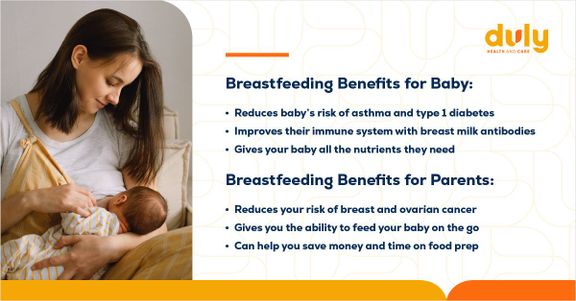As you await the arrival of your baby, you will experience many different changes in your body. You might crave some foods — or be absolutely grossed out by others. Your belly will expand as your baby grows, and you may find yourself needing to use the bathroom more.
All of these changes are normal and are part of how your body supports your baby throughout your pregnancy. Some changes in your body aren’t for your baby now but are meant to support them later.
Throughout your pregnancy, you will experience some breast changes. These changes are to help your body prepare to nurse your newborn and you may be surprised how early you start noticing them. Here are 3 ways your body is getting ready to breastfeed — and 3 ways you can prepare, too.
1. Your Breasts Become Fuller
Early in your pregnancy, you might notice that your breasts become fuller and more tender than before. It might seem like it’s too early for changes in your body around the fifth or sixth week, but even then, your hormones are telling your body a baby is on the way. Throughout your pregnancy, your breasts will continue to grow in shape — even the kinds of tissue in your breasts will change. What is generally fatty and supportive tissue, becomes glandular tissue which allows you to produce milk and nurse your baby.
2. Your Areolas Become Bigger and Darker
During pregnancy, you might notice that your nipples and the areolae around them become larger or darker in color. These changes are meant to help your baby while breastfeeding, by being able to find your nipple more easily. Your baby’s vision at birth won’t be fully developed, and the color difference between your skin and your darkening nipple makes a big difference in their ability to locate and latch effectively.
You may also notice your nipples producing some of your first milk before your baby actually arrives. Your body is able to produce milk by the end of your second trimester, so you might notice some light yellow or orange staining inside your bra.
3. There Are More Bumps on Your Areolas
Another change in your body during pregnancy is an increase in the number of small bumps on your areolas, known as Montgomery’s glands. These bumps play an important role in breastfeeding by emitting oils that lubricate and protect the nipples, preventing them from drying out and cracking. Because of these important oils, avoid washing your nipples with soap or using disinfectants which can dry out your skin. Rinse only with warm water.

How You Can Prepare for Breastfeeding, Too
While your body has already started getting ready for breastfeeding while pregnant, there are also ways you can prepare, too. Taking steps to get ready for breastfeeding can help you feel confident in your choices and your ability.
1. Attend a Prenatal Breastfeeding Class
Before your baby arrives, you can take a prenatal breastfeeding class with a Duly lactation consultant. In a prenatal breastfeeding class, you can learn latching and positioning techniques, how your body produces milk, how to pump and store milk, and so much more. Even if you aren’t sure if you plan to breastfeed or know you don’t want to, a prenatal breastfeeding class can still help you learn about the different changes in your body and your options for feeding after your baby arrives.
2. Set Up Your Home for Breastfeeding
Preparing your home for breastfeeding can make your journey smoother and more enjoyable once your baby arrives. Consider investing in a breast pump, a helpful tool that allows you to express milk and create a stash for times when you’re away or need a break. Many health insurers cover the cost of a breast pump, but you may need a prescription from your OB/GYN.
You can also set up a comfortable breastfeeding station in your home, with pillows, a nursing chair, and even a side table for essentials like water, snacks, and burp cloths. Creating a calm nursery environment can make your and your baby’s breastfeeding experience better. You can also stock up on breastfeeding supplies such as nursing bras, breast pads, and lanolin cream for nipple care.
3. Build Your Support System
Most importantly, surround yourself with a support network of friends, family, and lactation consultants who can be with you and provide guidance and encouragement on your breastfeeding journey.
Health Topics:








